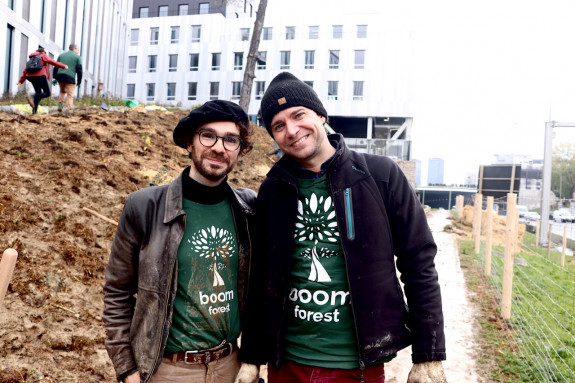Tiny Forest France

Profile: Enrico Fusto (right) together with Damien Saraceni (left)
Organization: Boomforest France
Email address: info@boomforest.org
What was your personal motivation to plant your first or your favourite forest?
Enrico: The question that came to our minds at the beginning of our adventure, back in January 2016, was: “Can people restore nature ecosystems in the places where they live, effectively and without big investments?”. Our first forest in Paris is an answer to that question. As we went deeper into the Miyawaki method by trial and error, we saw that it was a very approachable method for all of us: a team of people and citizens with little or no knowledge of botanic expertise before starting the project.
Can you describe the surroundings of your first forest, what type of place did you convert?
Enrico: The first forest we planted was in a parcel alongside the Eastbound Paris ring-road (boulevard Périphérique). This was a terrain made of a clayey soil and poor in terms of life and biodiversity. We chose that place for two reasons. Firstly, because the neighbourhood next to the ring-road is the most exposed area to vehicle noise and pollution and people could directly benefit from a natural barrier made of trees. This would offer them some relief. Secondly, because the ring-road embankment lawns are not directly accessible to people, it has big potential to become a great ecological corridor.
What were the biggest obstacles in planting this forest?
Enrico: At the beginning we only had a vague knowledge of the natural potential vegetation of the local zone in which we were going to plant and there were no consistent listings to verify our first plant set. So we took some time to study and to talk with experts in the botanic business. Our contacts within the Miyawaki team in Japan really helped us a lot in validating the first list of species.
Who did you cooperate with? How did the local community respond to the forest?
Enrico: Since the beginning we opted to include the Paris Municipality with our objective and decided to apply for the “Budget Participatif de la Ville de Paris”. This is a public framework to propose and promote projects that stimulate the participation of citizens. We applied that framework with the idea of planting the first forest as part of a series, in the Paris ring-road. Many people voted for our project and the Municipality of Paris validated it! Local participation was a key factor to make the project such a success. Everyone suddenly understood the importance of planting ecosystems and, at the same time, they were part of the preservation of this ecosystem by participating.
Did you encounter any rare species of plants and animals? Or which did you never expect to find in your forest?
Enrico: Of course! Not only plants of the known local species started to autonomously reproduce in the borders of the planted mini-forest, we also found some species of local berries and flowers that we didn’t plant. Moreover, there are many birds all over the site, trying to find a protected place to settle, as well as insects like bees, ladybugs, beetles, etc. Also, based on measurements, we found that the underground life is richer than before the plantation in terms of earthworms and fungi.
What did you learn from your first forest?
Enrico: We learnt a very powerful thing: nature is always there. It is ready to restart, we only have to help nature to take back its presence on places where it is difficult. But, when helping a hand, nature continues the job by itself and biodiversity autonomously extends its borders, meter after meter. For us, understanding this was a tremendous breakthrough in our mindset. This underlines even more the importance of little man-made forests in the bigger picture of ecosystem restoration. Anyone can make a difference in this.
What is the next thing you want to learn about in forest making?
Enrico: We would like to learn how to make a nursery for forest species. We would like to do this in a participative way, so citizens can be (even more) part of the forest making process. We think that, if information on forest nursery techniques and forest making would be more accessible, more people will easily join the momentum. This will lead to more chances and projects to fight against global warming!

